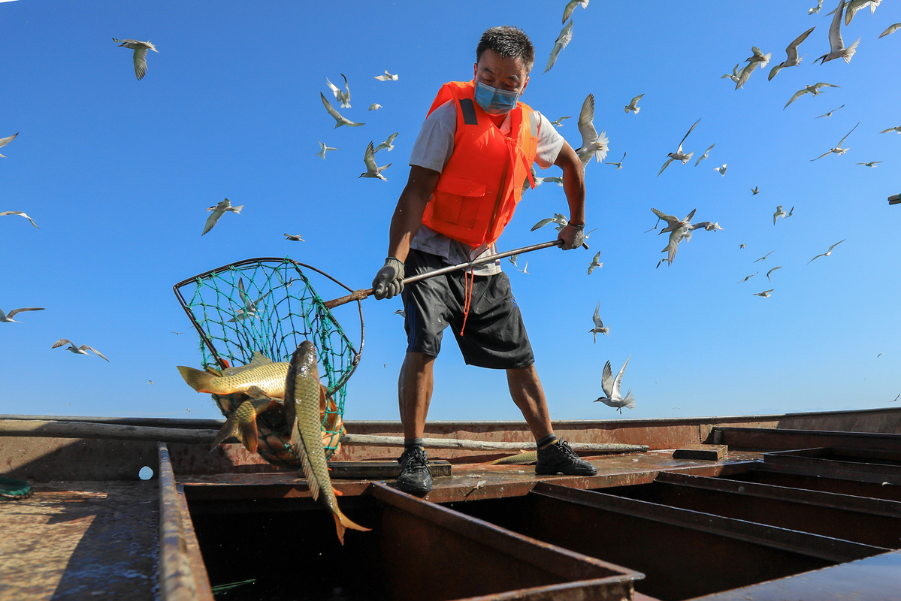
A fisherman catches fish on his boat in Bohu county of Bayingolin Mongol autonomous prefecture, Xinjiang Uygur autonomous region, on Aug 8, 2020. [Photo/Xinhua]
According to Guinness World Records, Urumqi, capital of the Xinjiang Uygur autonomous region, is further from the sea than any other city in the world.
But that hasn't stopped China's westernmost region from shattering its cliched dry, barren and deserted image by developing a successful fishery in its Bortala Mongolian autonomous prefecture.
Liang Jing, an official from Wenquan county in Bortala, said the reason lies in its Sayram Lake, a place where the locals believe warm and humid ocean air ends up.
"Sayram Lake is the highest altitude and the largest alpine lake in Xinjiang," Liang said. "Its water quality is remarkable, and with a low but stable underwater temperature, researchers found the 453-square-kilometer lake is quite suitable for certain fish farming."
The lake held no fish until a local aquaculture body decided to introduce the northern whitefish (Coregonus peled), a well-adapted cold-water fish, from Russia in 1998. After a successful breeding experiment two years later, Sayram started a new chapter in fishery development.
In late November each year, Ma Zhuang, a senior manager at the Saihu fishery company, organizes his breeding team to start the artificial insemination and hatching process. Their goal is to make sure more healthy fingerlings survive until the next June, when they can be put into the lake.
"When the fish were first introduced, the survival rate during hatching was around 3 percent and the size of our business was entirely dependent on how many fish eggs foreign companies could provide," Ma said.
In 2000, the local fishery authorities invested 3.4 million yuan ($520,000) on a fish-breeding base.
Government investment in breeding infrastructure and technology boosted the fishery's development, and the company has hired more professionals to conduct research.
"I still remember we often stared at the microscope for five or six hours in order to make a little breakthrough on artificial breeding back then," said Hou Yujun, a biotechnology engineer at the company.
The artificial breeding technology gradually matured in the next decade as the company researched and optimized new hatching techniques, and the survival rate increased to 36 percent.
"We were able to buy a few million eggs before, but now we can hatch hundreds of millions of eggs a year," Hou said. "Now the sole purpose of importing eggs from abroad is to improve the breed."

Two fishermen show fish they caught in Bohu county of Bayingolin Mongol autonomous prefecture, Xinjiang Uygur autonomous region, on Aug 8, 2020. [Photo/Xinhua]
After hatching in spring, the whitefish fingerlings are placed in a new pond where they can grow 4 centimeters in the first month.
"It's a remarkable achievement since the fish could only grow 2 centimeters in three months at our previous breeding workshop when they were first introduced here," Hou said.
In June, most of the surviving fish are put into the lake, with the rest bought and raised by local farmers.
"We offer those mature fingerlings to the farmers every year at a very low price, and they can sell the fish in the market once they reach 700 grams, which usually takes two years, or they can sell them to us for a little higher than the buy-in price," Ma said.
Fish growing in the lake take three to four years to reach the optimum marketable weight of more than a kilogram.
After years of learning and improving fishery techniques, the lake has become an important cold-water fish production base, with the company now one of China's largest exporters of northern whitefish with annual output of more than 400 metric tons.
As output increased, the company decided to improve the industrial chain by building an 8,000-square-meter processing factory in 2015. Ma said it meets high design standards set by the European Union.
"We are able to make those fish into packaged goods once they are caught and can deliver to any restaurant in need across the country within 24 hours," he said.
The company has also invited professional caviar makers from Finland to visit every year since 2016 to teach its workers how to make caviar.
"Since the COVID-19 outbreak, we have stopped exporting the caviar to European countries, but in 2019 the export volume reached 15 tons," Ma said. "I believe there will be more after everything is back to normal."
Today, Sayram has also become a popular stop for visitors. When traveling by the lake, they can always find food trucks selling fresh fish products.
"The fish products sold by the trucks are northern whitefish just caught from the lake," Ma said. "And the trucks making real money are run by the locals."







